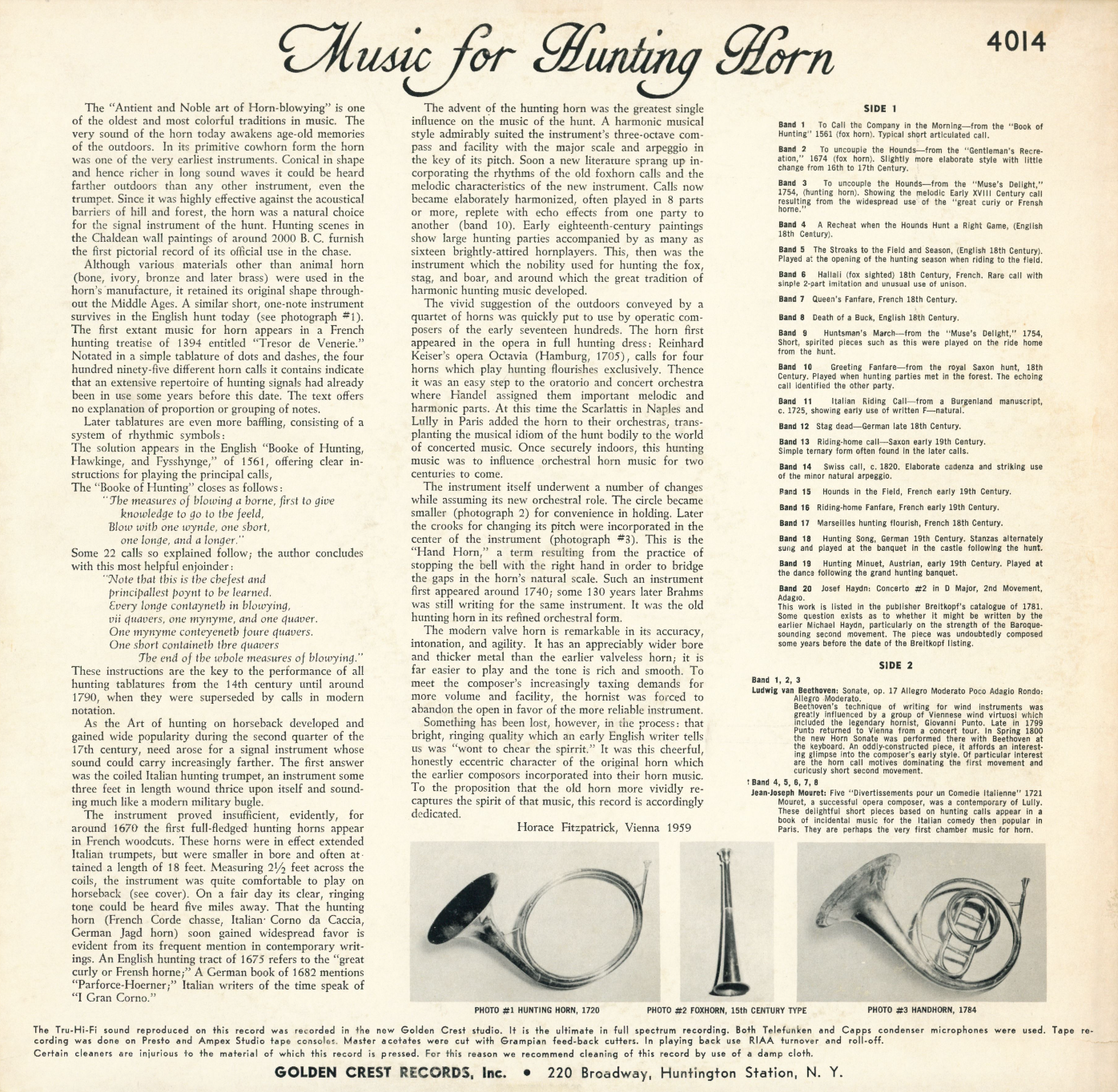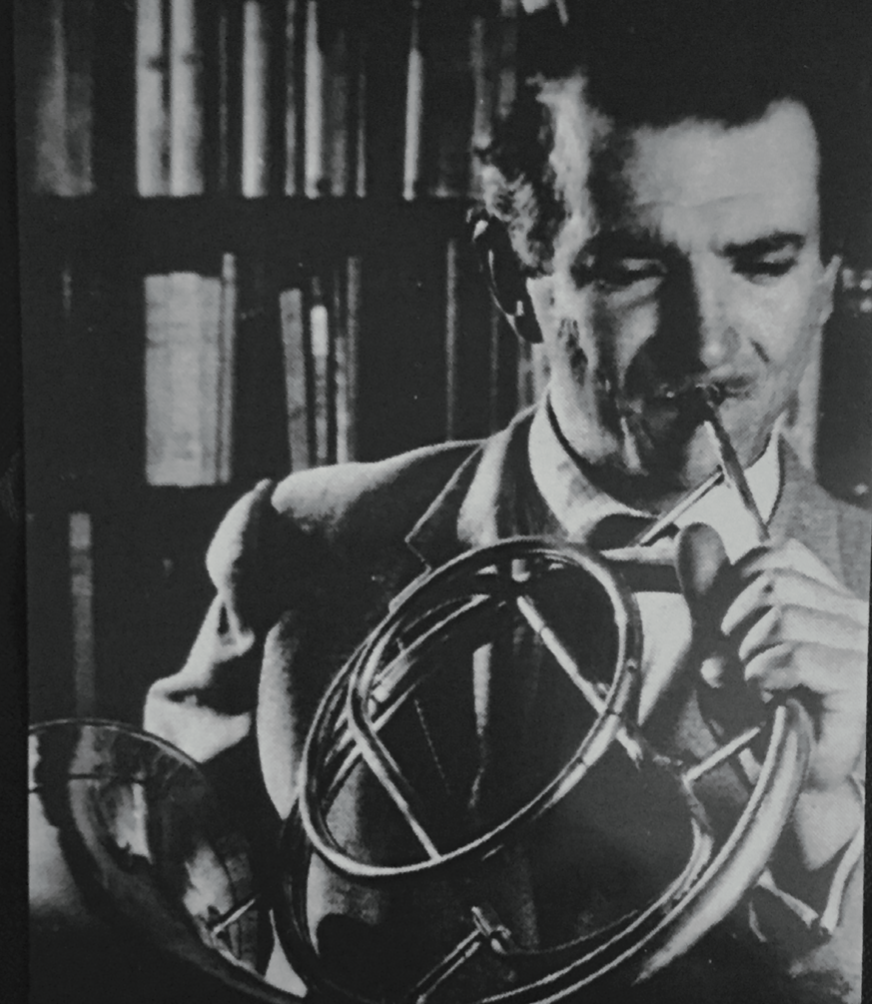Volume 22 - Horace Fitzpatrick
It’s exciting to resume writing these articles after a long pause while organizing and hosting IHS 57! This month’s album has been one I’ve wanted to write about since the series began, and it feels fitting to resume with a record that ties together so many fascinating aspects of early horn repertoire and our instrument’s lengthy heritage. Released on Golden Crest Records in 1960, let’s dive into Horace Fitzpatick plays Music for Hunting Horn 1561-1840 on instruments of the period.
Horace Fitzpatrick (1934-2020) authored one of the mostly deeply researched and respected histories of our instrument, his 1970 publication The Horn and Horn-Playing and the Austro-Bohemian tradition 1680-1830 for Oxford University Press. While his focus and research was very euro-centric, Fitpatrick was actually born in Kentucky and studied with Philip Farkas at Northwestern University, continued by a Master of Music from Yale. The following phase of his career takes an unexpected turn, as he relocates to Austria to pursue studies at the Music Academy with Gottfried von Frieburg, solo horn of the Vienna Philharmonic. It is during his subsequent employment with the Vienna State Opera and Palazzo Pitti Chamber Orchestra in Florence that he develops an deep interest in historical horns and their performance practice. Fitpatrick became one of the leaders of the early instrument revival, presenting several recitals and lectures on the topic and notably taught natural horn at the Guidhall School and aided in establishing the Bates Collection of historic musical instruments at Oxford University.
As you will see from reading the reverse album jacket, the album track list presents a chronological account of traditional hunting calls from the 15th-19th centuries performed on both fox horn and trompe de chasse. In addition to the very detailed and illuminating historical notes Fitzpatrick provides on the album jacket, he also records several of the hunting calls in multi-track and is performing all of the harmonized parts together himself.
This album is truly fascinating as an inception point for recorded performance-practice on the horn. Fitzpatrick was a well-trained hornist and passionate reasearcher of early horn history, especially the development of the instrumnent and the it’s pathway from forest hunting calls to its use as a true concert instrument. Let’s listen to two examples of these early calls - first, “To uncouple the Hounds from the "Muse's Delight" 1754:
“Marseilles hunting flourish”, French 18th Century.
In both of these examples, Fitzpatrick captures the compound meter cadence and spirited nature of these calls. However, he was likely unaware of the deeply rooted performance techniques of trompe de chasse performers in France, Belgium, Netherlands, and Luxembourg – these include the “blowing in” of first phrase notes and a very pervasive vibrato, expertly coordinated between the players when there are harmonized parts.
This album also very notably appears to be the first recording of Beethoven’s Horn Sonata Op. 17 featuring a performance on natural horn! There are certainly earlier interpretations of this sonata, with the first being Fitzpatrick’s teacher Gottfied von Freiburg’s recording from 1937, followed by Dennis Brain in 1944 for Columbia and Mirslav Štefek in the late 1940’s for Supraphon. But Fitzpatrick’s is the first attempt to truly showcase Beethoven’s use of open and closed notes melodically on the natural horn in his 1960 recording.
The opening of the Sonata sounds that well-known opening horn cal! Fairly deft hand-stopping by Fitzpatrick then captures Beethoven’s use of closed notes to voice-lead to stronger cadential open notes:
The next excerpt is the opening of the development section – here Fitzpatrick is not subtle with the interplay of closed and open notes, and the usage rate of closed notes is much higher here than in any other section of the piece. We notice a stylistic use of vibrato that would have been informed from his research as well:
The final selection comes from the coda of the Sonata’s third movement. Fitzpatrick serves up a penetrating open Bb and tackles the following athletic arpeggiations with verve!
This recording of Beethoven’s Sonata is perhaps not the nuianced musical journey that many more modern natural horn performers and recording artists are able to produce. However, if we imagine back to 65 years ago before the likes of Tony Halstead or Lowell Greer started to embrace the true range of technical and artistic capabilities of the natural horn, we can see Fitzpatrick’s work as a revolutionary endeavor worthy of appreciation and respect. Certainly if you have not read his 1970 publication and are interested in horn history, it is an absolute cornerstone of our research literature.
As a last note, I left the pricetag on the album cover – I found this album in mint-condition for $1 about 20 years ago! You never know what you’ll find when you’re treasure hunting!
Thanks for reading Horn on Record!



